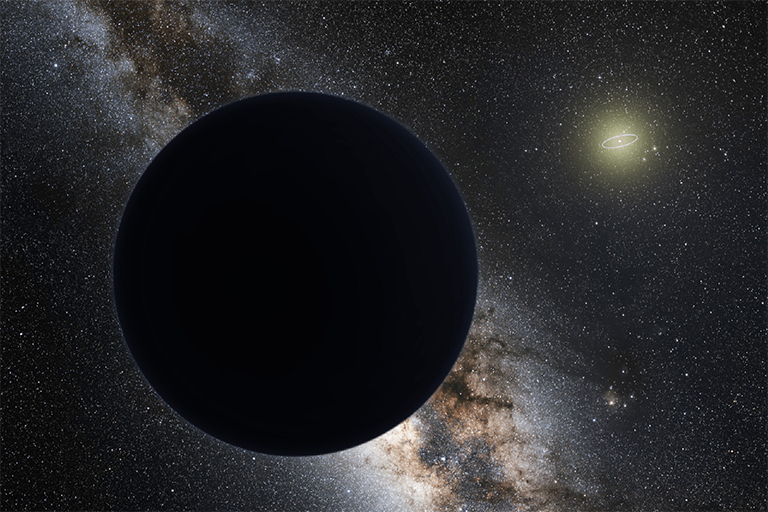Our solar system has eight planets. In 2006, astronomers reclassified Pluto as a dwarf planet, the same class that contains Eris, Sedna, Quaoar, Ceres, and perhaps many more small bodies. These are defined approximately as bodies that orbit the Sun but that are not large enough (unlike regular planets) to gravitationally dominate their environments by clearing away material.
Astronomers wonder if there might be a ninth planet undiscovered but lurking in the outer reaches of the solar system, perhaps in the giant Oort cloud of objects that begins hundreds of astronomical units (au) from the Sun and extends outward.
The notion that there may be a ninth massive planet in the outer solar system has taken on new appeal with recent data showing that the orbital parameters of some small bodies beyond Neptune (their inclinations, perihelions, and retrograde motions) seem to behave as though they had been influenced by the gravity of a massive object in the outer solar system. Although these data suffer from observational biases and statistical uncertainties, they have triggered renewed interest in the idea of the presence of another planet.
This speculative Planet 9, according to estimates, would be about 5 to 10 Earth masses in size and orbit about 400 to 800 au from the Sun. A planet at this distance would be extremely difficult to spot in normal optical sky searches because of its faintness, even to telescopes such as PanSTARRS and LSST.
Most solar system objects were discovered at optical wavelengths via their reflected sunlight, but the sunlight they receive drops, as the inverse square law for electromagnetic radiation says that measured light intensity is inversely proportional to the distance squared from the source of radiation. Moreover, the reflected portion then travels back to telescopes on Earth and so declines again by a similar factor.
In the outer reaches of the solar system these objects, although cold, might emit more infrared radiation than the optical light they reflect, and astronomers in the past have used infrared surveys such as the Wide-field Infrared Explorer (WISE) to search, but without success.
Centre for Astrophysics (CfA Harvard) astronomer Benjamin Schmitt was a member of a large team that used the 6-metre Atacama Cosmology Telescope (ACT) in Chile to search for Planet 9 at millimetre wavelengths. Although ACT was designed to study the cosmic microwave background radiation, its relatively high angular resolution and sensitivity makes it suitable for this type of search.
The astronomers scanned about 87% of the sky accessible from the Southern Hemisphere over a six-year period, then processed the millimetre images with a variety of techniques, including binning and stacking methods that might uncover faint sources but at the expense of losing positional information. Their search found many tentative candidate sources (about 3,500) but none could be confirmed, and there was no statistically significant detection.
The scientists, however, were able to exclude with 95% confidence a Planet 9 with the above-estimated properties within the surveyed area, results that are generally consistent with other null searches for Planet 9. The results cover only about 10-20% of the possibilities, but other sensitive millimetre facilities are coming online and should be able to complete this search for Planet 9.


